

| Circe
| Monday, February 1, 2010 First on the agenda was to overbore the fastener holes for the pulpits and stanchions as required. At each fastener location (the stern pulpit and aftermost stanchion bases were located in areas with solid glass deck and no core, so this work wasn't required in those areas), I drilled as large a hole as practicable (5/8") through the top deck skin and core material to omit the core in way of each fastener. I left the bottom deck skins intact. While I was at it, I removed the plastic dodger track and frame-mount hardware, which had been only temporarily installed during last week's templating efforts, and prepared the fastener holes in similar manner, though the small footprint of the hardware required much smaller holes. I cut backing plates for the the stanchion and pulpit bases from prefabricated fiberglass sheets, and secured these to the underside of the deck in the appropriate positions with epoxy adhesive. To hold the backing plates in position while the epoxy cured, I used dabs of hot glue. Afterwards, I filled all the previously-bored holes with thickened epoxy and left it to cure. |
|
One of the main tasks for this week was to paint the overhead in the cabin, a long-awaited event. With new interior cabinets and certain trim pieces still going into place up to only a few weeks ago, it hadn't been the right time to take care of the painting till now. To that end, I masked off the cabinetry as needed, and protected areas with additional tape and paper as I deemed necessary to avoid any paint splatters. I'd originally thought of painting the settee tops during the same sessions, but ultimately decided there was enough work still ahead in the interior and systems that it'd be prudent to await beginning the settee finishing till later in the process, lest the new paint become scarred. In some of the seams between bulkheads, cabinets, and the overhead, I applied small beads of caulking to smooth the seam and provide a pleasing appearance; these areas would be painted over during the process. Therefore, I didn't attempt to begin the primer process this day, allowing the caulk time to cure before beginning. |
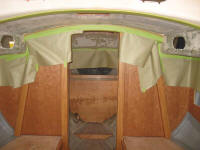

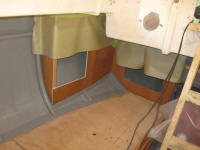 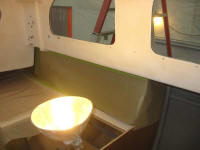 |
|
To finish up the day, I permanently installed the dodger hardware, as the epoxy product I'd chosen had a quick cure time that allowed me to continue. I mounted the tracks and frame mounts in a bed of polysulfide, secured them with screws as before, and cleaned up the excess sealant. |
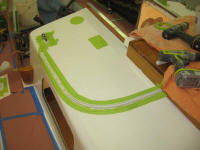
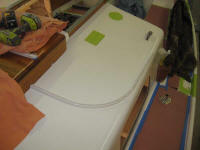 |
|